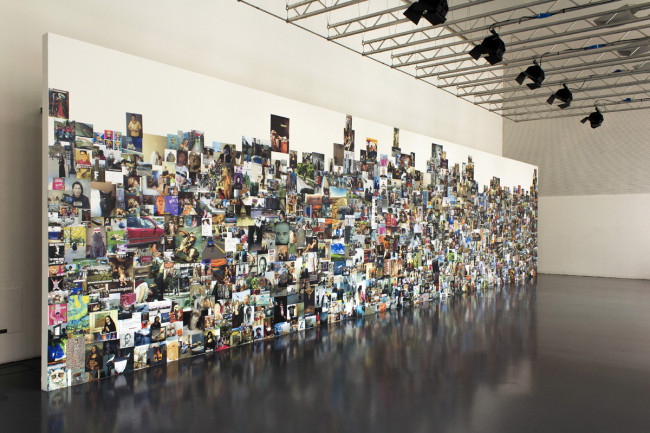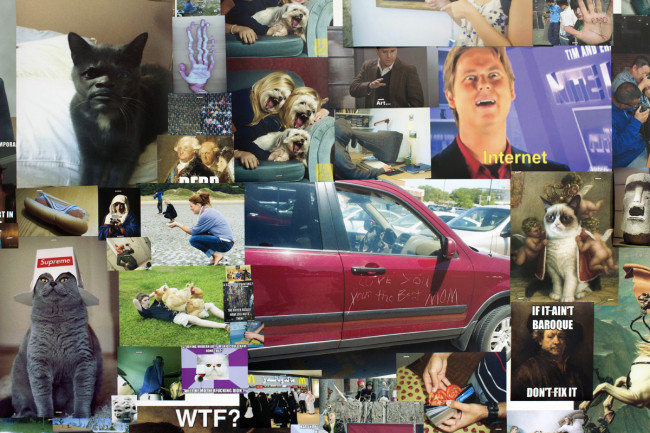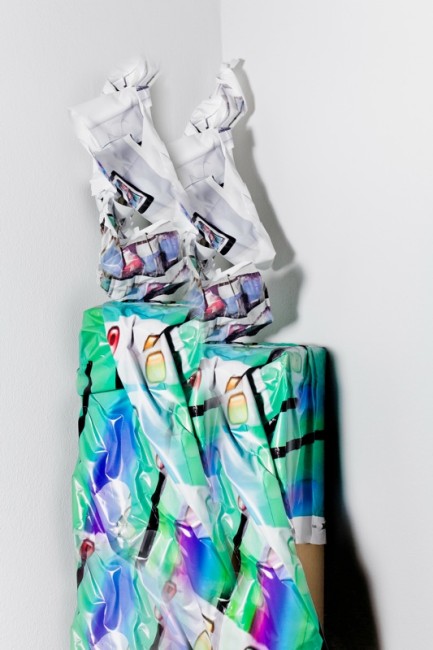Nothing to see here…
La cultura visiva al tempo di Internet
30 maggio – 12 luglio 2013
A cura di: Valentina Tanni e Domenico Quaranta
Allestimento: Canedicoda
Compiler 04 / selezione video a cura di Raffael Dörig
Istituto Svizzero di Roma – Sede di Milano
Via Vecchio Politecnico 3 (Centro Svizzero), Milano
www.istitutosvizzero.it
Cocktail: sabato 1° giugno, dalle 18 alle 23
18 giugno, dalle 18: Inaugurazione della mostra di Adam Cruces ed Enrico Boccioletti e talk con gli artisti e i curatori
Nothing to see here è una mostra in due parti e una discussione sull’arte e la cultura visiva al tempo di Internet nella sede di Milano dell’Istituto Svizzero, dal 30 maggio al 12 luglio 2013.
L’iniziativa, a cura di Valentina Tanni e Domenico Quaranta, si configura come un momento di riflessione sullo statuto delle immagini nella società contemporanea. La diffusione globale dei computer e di Internet, che ha fornito a un grandissimo numero di utenti l’accesso agli strumenti di produzione e di distribuzione delle immagini, ha innescato una vera e propria esplosione della creatività a tutti i livelli. Ne risulta un universo visivo multiforme e indefinito – fatto di prodotti culturali amatoriali, irregolari, creazioni anonime e collettive, memes e video virali – che spesso sembra evocare e riproporre linguaggi e pratiche riconducibili alle avanguardie artistiche, storiche e recenti. Nothing to see here vuole offrire una panoramica su questo movimento disomogeneo e vitale, che avviene fuori dai circuiti istituzionali e sta lentamente dando forma a una nuova cultura, che mette radicalmente in discussione il modello professionistico nel settore delle arti e ci costringere a ripensare l’attività creativa tutta e il suo ruolo nella società.
L’argomento sarà affrontato presentando, in mostra e durante il talk del 18 giugno, sia i prodotti della cultura amatoriale che quelli degli artisti che si confrontano attivamente con questo nuovo scenario.
A partire dal 30 maggio l’ISR a Milano ospiterà un grande wall di immagini provenienti dal web (circa un migliaio): un collage multiforme e caotico costruito con l’obiettivo di trasferire nello spazio fisico un pezzetto di quel magma di visioni e creazioni che si espande senza sosta e ci raggiunge ogni giorno attraverso lo schermo dei nostri computer. L’allestimento del wall è a cura di Canedicoda.
Su questo sfondo saranno presentate anche due selezioni di video: la prima parte, dal titolo Don’t watch if you dislike, è composta da video amatoriali disponibili su Youtube; Compiler 04, a cura di Raffael Dörig, presenta invece opere video firmate da un gruppo di giovani artisti di provenienza internazionale che si confrontano, a livello estetico e concettuale, con le culture di Rete.
Il 1° giugno, nell’ambito del Wired Next Fest 2013 che si svolge in contemporanea nei Giardini Indro Montanelli di Via Palestro, l’Istituto Svizzero presenta (in collaborazione con l’EPFL – Ecole Polytechnique Fédérale de Lausanne e Reflex Magazine) una panoramica su alcune delle più innovative iniziative tecnologiche – svizzere e internazionali – nell’ambito della gestione dei dati hardware e software applicata all’urbanistica.
Reinventing Cities: Architecture, Urbanism and Data si terrà al Wired Drome (ingresso da Corso Venezia, Milano) dalle ore 19.45 alle 20.45. Gli ospiti del panel sono Hannes Gassert (Opendata.ch), Sophie Lamparter (swissnex San Francisco), Daniel Saraga (managing editor Reflex Magazine), Gerhard Schmitt (Future Cities Laboratory Zurich/Singapore, ETH Zurich) e Ian F.C. Smith (School of Architecture, Civil and Environmental Engineering ENAC, EPFL).
Il 18 giugno, all’ISR a Milano saranno presentati i lavori di Adam Cruces ed Enrico Boccioletti. Il lavoro dei due artisti andrà ad affiancarsi alle due compilation video, completando la mostra.
Lo stesso giorno si svolgerà un talk sui temi del progetto. Partecipano alla tavola rotonda i curatori, Valentina Tanni e Domenico Quaranta, Raffael Dörig, critico e curatore di base a Basilea, direttore della Kunsthaus Langenthal, Adam Cruces ed Enrico Boccioletti. Durante l’incontro sarà presentata Compiler 04, la compilation di video d’artista presente in mostra, pubblicata sotto forma di DVD nel 2012 e distribuita da Motto Distribution (Berlino).
—–
L’universo delle immagini sta cambiando. La diffusione su ampia scala di personal computer e connessioni Internet ha permesso di emanciparsi dal semplice ruolo di spettatore, partecipando attivamente alla costruzione della cultura visiva contemporanea. L’aspetto più sorprendente riguarda però l’utilizzo, da parte di questi nuovi “amatori”, di estetiche, linguaggi e codici cari all’arte contemporanea storica e attuale: il remix, il détournement, la surrealtà, lo spostamento di senso, il recupero e il riutilizzo di materiali di archivio, l’accostamento di arte “alta” e cultura popolare. Un’eredità, questa, che pur non sempre assorbita consapevolmente, sembra tuttavia prendere nuova vita a contatto con la nuova, selvaggia, linfa culturale del web.
L’appropriazione, il riuso, il cut-up e il reenactment, pratiche una volta considerate esclusive dell’universo artistico, fanno ormai parte di un lessico popolare e allargato, che obbliga a ripensare il ruolo dell’artista come creatore di immagini e dell’opera d’arte come vettore di significato all’interno della società. Stiamo assistendo a un’esplosione di micro-culture, che si sviluppano a ritmi frenetici e si intrecciano tra loro senza uno schema apparente e che insidiano, giorno dopo giorno, la capacità aggregante – ma anche omologante – del mainstream e dei sistemi economici che lo supportano.
Immagine tra le immagini, l’arte viene riassorbita nel maelström della cultura visiva, finendo per subire, da parte di una massa di anonimi creatori, il medesimo trattamento che lei stessa ha introdotto e praticato per decenni: un trattamento fatto di appropriazione, remix, détournement, costruzione di immagini surreali, uso del nonsense e dell’ironia come veicoli di risveglio dell’immaginazione e delle coscienze, elogio del fallimento (che oggi, al tempo della Rete, si chiama epic fail), giustapposizione di immagini e testi di diversa provenienza.
Nothing to see here è un tentativo di riflettere su questo scenario, che da una parte mette in discussione il ruolo dell’arte, ma allo stesso tempo sembra rilanciarlo attraverso il meccanismo della sfida.
Cosa significa oggi essere produttori di immagini? In che modo queste sono lette e recepite dal pubblico (un pubblico che a sua volta è diventato produttore di contenuti)? E infine – la domanda forse più radicale e per questo destinata a restare aperta, ma che accoglie risposte e interpretazioni personali da parte di ciascuno di noi: in che modo è mutato il nostro sguardo, l’atto stesso della visione?
ENGLISH VERSION
Nothing to see here is an exhibition in two parts and a discussion on art and visual culture in the era of the Internet at the Milan branch of the Istituto Svizzero, from 30 May through to 12 July 2013.
The initiative, curated by Valentina Tanni and Domenico Quaranta, is articulated as a moment of reflection on the status of images in contemporary society. The global diffusion of computers and the Internet, that supplied a vast number of users with the access to tools to produce and distribute images, has triggered a real explosion of creativity at every level. A multiform and undefined visual universe is the result – made of irregular, amateur cultural products, anonymous and collective creations, memes and viral videos – that often seem to evoke and repropose languages and practices that are linked to the avant-gardes, both historical and recent. Nothing to see here wishes to offer an overview of this irregular and vital movement, that takes place outside the institutional circuits and is slowly giving shape to a new culture, that radically questions professionalism in the art practice and forces us to rethink the creative activity and its role in society.
The question will be dealt with by presenting, in the exhibition and during the talk on 18 June, both the products of the amateur culture and those of artists who are actively confronting this new scenario.
Starting from 30 May the ISR in Milan will host a large wall of images from the web (circa a thousand): the multiform and chaotic collage with the aim of transferring into the physical space a piece of that magma of visions and creations that is expanding without stopping and reaches us every day through the screen of our computers. The set up of the wall is curated by Canedicoda.
On this background also two selections of videos will be presented: the first part, entitled Don’t watch if you dislike, consists of amateur videos available on YouTube; Compiler 04, curated by Raffael Dörig, instead presents works by a group of young artists of international provenance that confront themselves, at aesthetic and conceptual level, with the cultures of the web.
On 1 June, in the context of Wired Next Fest 2013 that takes place simultaneously in the Indro Montanelli Gardens in Via Palestro, the Istituto Svizzero will present (in collaboration with the EPFL – Ecole Polytechnique Fédérale de Lausanne and Reflex Magazine) an overview of some of the most innovative technological initiatives – Swiss and international – in the context of the management of hardware and software data applied to urbanism.
Reinventing Cities: Architecture, Urbanism and Data will be held at the Wired Drome (entrance Corso Venezia, Milano) from 7.45 p.m. until 8.45 p.m.. The panel guests will be Hannes Gassert (Opendata.ch), Sophie Lamparter (swissnex San Francisco), Daniel Saraga (managing editor Reflex Magazine), Gerhard Schmitt (Future Cities Laboratory Zurich/Singapore, ETH Zurich) and Ian F.C. Smith (School of Architecture, Civil and Environmental Engineering ENAC, EPFL).
On 18 June, at the ISR in Milan the works of Adam Cruces and Enrico Boccioletti will be presented. The work of the two artists will go alongside the two compilation videos, thus completing the exhibition. The same day a talk on the themes of the project will take place. Taking part in the round table will be the curators, Valentina Tanni and Domenico Quaranta, Raffael Dörig, critic and curator based in Basel, director of the Kunsthaus Langenthal, Adam Cruces and Enrico Boccioletti. During the meeting Compiler 04 will be presented, the compilation of artist videos present in the exhibition, published in DVD format in 2012 and distributed by Motto Distribution (Berlin).
—
The universe of images is changing. The wide-scale diffusion of computers and access to the Internet have made it possible for a vast number of people to emancipate themselves from the role of spectator, by actively participating in the construction of the contemporary visual culture. The most surprising aspect however regards the use, by these new “amateurs”, of aesthetics, languages and codes dear to historical and current contemporary art: appropriation, remix, détournement, surreality, reenactment, the shift of sense, the recovery and reuse of archive materials, the combining of “high” art and popular culture, the ironic comment. A heritage that is not always absorbed consciously, but that takes on a new life in contact with the new, wild, cultural lymph of the web.
All this imposes a rethink of the role of the artist as the creator of images and of the work of art as the vector of meaning within society. We are witnessing an explosion of micro-cultures, that develop in a frenetic rhythm and interweave without an apparent scheme and that threaten, day after day, the aggregating – but also homologating – capacity of the mainstream and of the economic systems that support it.
An image between images, art is reabsorbed in the maelström of visual culture, ending up undergoing, by a mass of anonymous creators, the very same treatment that it itself introduced and exercised for decades on the heritage of the past and on popular culture. Nothing to see here is an attempt to reflect on this scenario, which on the one hand questions the role of art, but at the same time seems to relaunch it through the mechanism of challenge. What does it mean, nowadays, to be producers of images? In what way are these interpreted and acknowledged by the public (a public which in turn has become a producer of contents)? And lastly, perhaps the most radical question, destined to remain open: in what way has our gaze changed, the very act of viewing?





